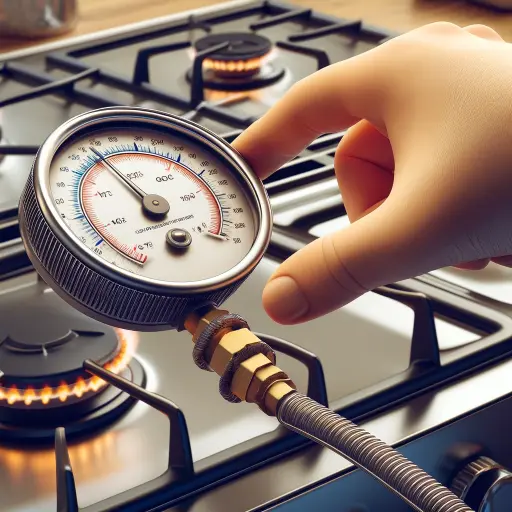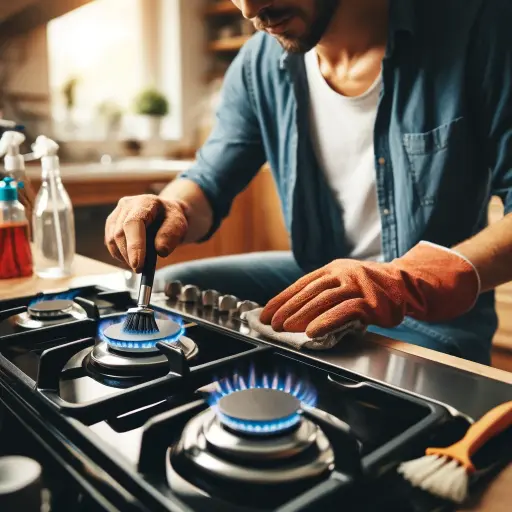Fix Red Flame on Gas Stove: Quick Solutions for Efficient Cooking
Updated: 30 Apr 2024
1408
Have you ever noticed a red flame flickering on your gas stove and wondered if it’s a sign of danger? It’s not just a quirky feature; it’s a signal that your stove might not be operating as efficiently as it should. Red flames can indicate serious issues, from safety hazards like carbon monoxide exposure to simple inefficiencies in fuel use.
In this post, you’ll learn how to diagnose and fix red flame gas stove issues, ensuring your stove runs safely and efficiently. We’ll explore everything from the basic causes of red and orange flames to step-by-step troubleshooting and preventive maintenance tips. “Keeping your family safe starts with understanding your appliances,” says Jane Doe, a certified gas safety expert.
By the end of this article, not only will you understand why your gas stove’s flame is red but also how to correct this potentially hazardous condition. We’ll provide practical advice and simple fixes that anyone can handle, giving you peace of mind every time you turn on your stove.
Causes of Red or Orange Flames
When you see a red flame or orange flame on your gas stove, it’s crucial to understand what’s causing this unusual color. Typically, a healthy gas stove flame should be blue, with perhaps a tiny hint of yellow at the tip, signaling complete combustion.
The primary cause of a red flame is often an imbalance in the air-to-gas ratio. Too much air or insufficient gas flow can lead to incomplete combustion, resulting in a flame that burns redder than normal. Another common culprit is the presence of impurities in the gas itself or dirt and debris clogging the burner.
“An optimal blue flame indicates efficient combustion, where the gas is being used effectively without wastage,” notes John Smith, a professional stove technician. This inefficiency not only affects your stove’s performance but can also increase your household’s gas consumption and costs.
Diagnosing Your Stove’s Flame Issue
Before attempting any fixes, it’s vital to correctly diagnose the issue with your gas stove’s flame color. Start by inspecting the burner for any visible signs of obstruction or residue. A clean burner is essential for proper gas flow and flame color.
Once the burner is clean, observe the flame as you adjust the air intake. If the flame remains red or orange, you might need to investigate the gas supply and quality further. It’s also a good idea to check if the stove is level because an uneven surface can affect the flame.

If these steps seem daunting, remember, “Safety should always be your first priority when dealing with gas appliances,” as recommended by Energy Star on their safety page. If you’re unsure or uncomfortable performing these checks yourself, it’s wise to call in a certified technician.
Accurately diagnosing the issue with your gas stove’s flame color is the first step toward ensuring it operates efficiently and safely. Here’s how you can methodically assess and pinpoint the cause of a red flame or orange flame:
1. Inspect the Burner
Begin by closely examining the stove’s burner. Look for any signs of dirt, grime, or corrosion that could obstruct the gas flow. Even small obstructions can alter the air-to-gas ratio, leading to color changes in the flame. Cleaning the burner might be all that’s needed to restore the proper flame color.
2. Adjust the Air Shutter
After cleaning, adjust the air shutter to modify the air intake. This is usually located at the base of the burner where the gas line connects. Adjust the shutter slightly and observe if there’s any change in the flame color. A proper adjustment can dramatically shift a flame from red to the optimal blue.
3. Check Gas Pressure and Quality

Low gas pressure can also cause the flame to appear red or orange. If adjusting the air intake doesn’t solve the problem, use a manometer to check the gas pressure. Ensure it aligns with your stove manufacturer’s specifications. Additionally, consider the quality of the gas; contaminants can affect combustion. We also recommend using a gas leak detector to detect potential gas leaks. Check out our detailed guide about the best gas leak detectors for the home and kitchen.
4. Evaluate the Stove Level and Installation
An uneven stove can lead to uneven gas flow and affect the flame color. Use a level to ensure your stove is perfectly horizontal. Also, verify that the stove installation was performed correctly, as improper installation can impact gas flow and safety.
5. Monitor Flame Consistency
Watch the flame as it burns. If the color fluctuates between blue and red, it might indicate fluctuating gas pressure or air intake issues. Consistent observation can provide clues to the underlying issues.
6. Seek Professional Advice
As emphasized by the American Gas Association, “Regular maintenance and professional inspections are key to safe and efficient stove operation.” If the above steps do not resolve the issue, it’s advisable to consult with a certified professional who can provide a more thorough diagnosis and possible solutions.
Maintenance and Prevention
Regular maintenance is key to preventing common gas stove issues such as a red flame on your gas stove and ensuring it operates efficiently and safely. Here are essential maintenance tips every stove owner should follow:

1. Regular Cleaning
Keep your stove and burners clean of grease, food particles, plastic, and debris. Regular cleaning not only prevents red flames but also enhances the overall efficiency of your stove. After cooking, once the stove is cool, wipe down the surface and the burners with a mild detergent solution.
2. Scheduled Inspections

Set a schedule for detailed inspections of your stove’s components. Look for signs of wear or damage in the burners, gas lines, and connections. If you notice any issues, address them immediately to prevent further complications.
3. Check Air Intakes Regularly
Ensure the air intake is always clear of obstructions. Periodically check the air shutters to make sure they are adjusted correctly and allow for the proper mix of gas and air.
4. Professional Servicing
According to the American Gas Association, “Annual servicing by a qualified technician is crucial for the long-term health of your gas stove.” This regular check-up can catch issues that might not be obvious during daily use.
5. Educate Household Members

Make sure everyone in your home knows how to use the stove safely and what to do in case of a problem. Understanding the importance of flame color can help in the early detection of issues.
Unanswered Questions and Common Problems
Despite many resources available, some questions and problems regarding stove use remain under-discussed or unresolved in typical content. This section aims to address some of these:
1. Adjusting for Altitude
How does high altitude affect your stove’s performance? It’s known that higher altitudes can affect combustion, requiring adjustments to air intake settings, which many manuals do not cover comprehensively.
2. Long-term Effects of Impure Gas
What are the long-term effects of using impure gas on your stove’s efficiency and safety? While most discussions focus on immediate effects like red flames, the chronic impacts are rarely addressed in depth.
3. Advanced Diagnostics Techniques
What advanced diagnostic techniques can be used at home to more accurately determine stove issues? Tools and methods are often available but not widely discussed outside of professional circles.
4. Environmental Considerations
How do environmental factors beyond altitude, such as humidity and ambient temperature, impact stove operation? This is another area where typical guidance is lacking.
Conclusion: Ensuring Safe and Efficient Stove Use
Maintaining a gas stove and ensuring it burns with a healthy blue flame is essential for both safety and efficiency. By following the steps outlined in this guide, from regular cleaning and maintenance to understanding and addressing the causes of red flames, you can enhance your stove’s performance and extend its lifespan.
Remember, a red flame is often a warning sign that should not be ignored. It indicates inefficiencies in combustion that could lead to increased fuel consumption and, more critically, safety hazards. Addressing these issues promptly not only keeps your stove running well but also ensures the safety of your home environment.
References
- https://www.researchgate.net/publication/236630237_Thermal_Performance_Analysis_of_Domestic_Cooking_Burners_by_Laser_Diagnostics
- https://www.researchgate.net/publication/264629917_Laboratory_based_assessment_of_cookstove_performance_using_energy_and_emission_parameters_for_North_Indian_cooking_cycle



Please Write Your Comments